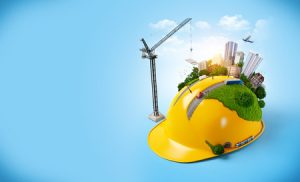Sustainable construction practices are on the rise amid both the residential and commercial sectors and are rapidly surpassing conventional construction methods. Ecologically conscious consumers primarily fuel the demand, with statistics citing construction-related industries are major US polluters that are culpable for: 23 percent of air pollution, 40 percent of water pollution and 50 percent of landfill waste. However, sustainable homes and commercial properties are in demand for a number of reasons such as being more comfortable, cost-efficient, healthy for inhabitants, and sustainable. Here are five growing trends in modern sustainable construction today.
Pre-Fabricated Modular Construction Materials
 The readiness of prefabricated materials have helped the modular construction industry resurface as a main player in the green movement for home and business owners. Prefabricating materials off-site has been shown to effectively reduce construction waste and toxic substances often left behind during traditional builds.
The readiness of prefabricated materials have helped the modular construction industry resurface as a main player in the green movement for home and business owners. Prefabricating materials off-site has been shown to effectively reduce construction waste and toxic substances often left behind during traditional builds.
Furthermore, these modular prefabricated pieces decrease construction time and help eliminate excess scrap materials. As a whole, modular constructions are designed to provide maximum comfort for occupants and control energy costs while reducing environmental impact through smart designs and the use of recyclable materials.
Zero-Energy Buildings
Zero-net energy buildings are those designed to balance out the amount of energy the construction uses with the total amount of renewable energy the site can create annually. Of course, these homes and buildings rely on solar energy sources. However, these home do consume non-renewable resources to a point, but they are ultimately money savers for owners while also reducing carbon emissions on a level beyond the site itself. These perks make this sustainable concept ultra popular with sticklers for being green.
Smart Window Installations
Just like other trends in smart technology, ultra energy efficient smart windows are making a huge splash on the construction scene. Just a touch of a button allows users to alter windows from crystal clear to opaque in just seconds. This lowers sunlight exposure and impedes UV rays that are harmful to people, furniture and artwork. Cutting back on direct sunlight penetration and glare can further reduce energy bills substantially. Owners wanting to be on the cutting edge of sustainable building should give smart windows strong consideration.
Passive Homes and Buildings
Passive constructions are gaining popularity in the US amid both the commercial and residential sectors, particularly within those that are connected multi-unit properties. Passive house constructions are built air-tight like a thermos but offer superior ventilation and air quality to occupants. They also maintain balanced temperatures indoors, regardless of outside influences. Other design factors for passive house qualifications include continuous insulation, triple-paned windows and the elimination of thermal bridging between connected units.
Tankless Water Heaters
While far from a newcomer to the building scene and sustainability, tankless water heaters are still on the rise in popularity. These small units take up far less space than traditional hot water tanks giving owners greater floor plan flexibility with their compact size. While small in size, tankless water heaters offer a continuous supply of hot water (no more morning woes for large families) and the water is actually cleaner because it’s freshly supplies as opposed to being stored in large tanks. One of the biggest draws is that these units only utilize hot water when needed, meaning that savings of up to 30 percent are often seen long-term. As an added bonus, tankless water heaters can last up to two decades which is double the norm for traditional tanks.
*Blog post contributed by Dylan Snyder
